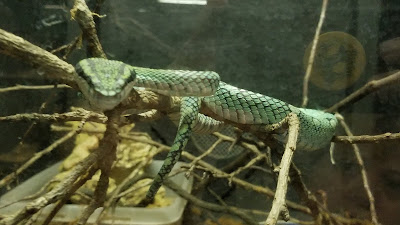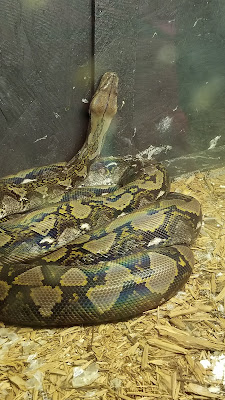Our host explained the rules of the serpentarium. No tapping on the terrariums and no running or yelling. He also told the kids that all terrariums are marked telling the name of the reptile and if it is venomous or nonvenomous. Once the rules were in place, he let them go into the two story building with over 120 terrariums.
The kids loved looking at all the reptiles. There were lizards and snakes in all sizes.
They were fascinated with the rattlesnakes. A few would start rattling their tails when people approached their terrarium. We were amazed at how loud the rattle was through the glass.
The king cobra would hood up when there were groups in front of its enclosure.
They even had a two headed snake that the kids found intriguing.
After an hour of looking at all the terrariums, everyone gathered around for our host to begin a question and answer session. We learned the difference between poisonous and venomous. He was great at giving examples of each.
He then explained the types of venom, hemotoxin and neurotoxin, and how they affect a person. The kids then wanted to know what was the most venomous snake they housed.
He discussed antivenom and explained how it was used. We learned that anti-venom is quite expensive. The main antivenom used in the United States is Crofab for pit viper bites. This is for rattlesnakes, copperheads, and cottonmouths. It is very expensive to treat snake bites. Luckily, snake bites are fairly rare, especially where we live.
One student asked about the biggest snake and he showed them the small anaconda they had at the serpentarium. He then talked about the pythons and how long they could become. He used two students to show the length of various big snakes.
Another asked about the snake's tongue. He explained how the snake used the tongue to smell and the Jacobson organ was part of that process. He then passed around a picture to show the students what the Jacobson organ looked like.
After the question and answer session, he brought out various pythons for the students to hold. He explained how to hold the snake and why the snakes tighten around the arm or neck. The kids loved getting to hold the snakes.
Finally, we went into the other room and he showed us a couple of tarantulas they had. Just like with the snakes, he explained how the spiders defend themselves. One brave student held the tarantula.
We spent over two and a half hours at the serpentarium. It was a fascinating place and the kids loved it! It is definitely a must do if in the area!




































